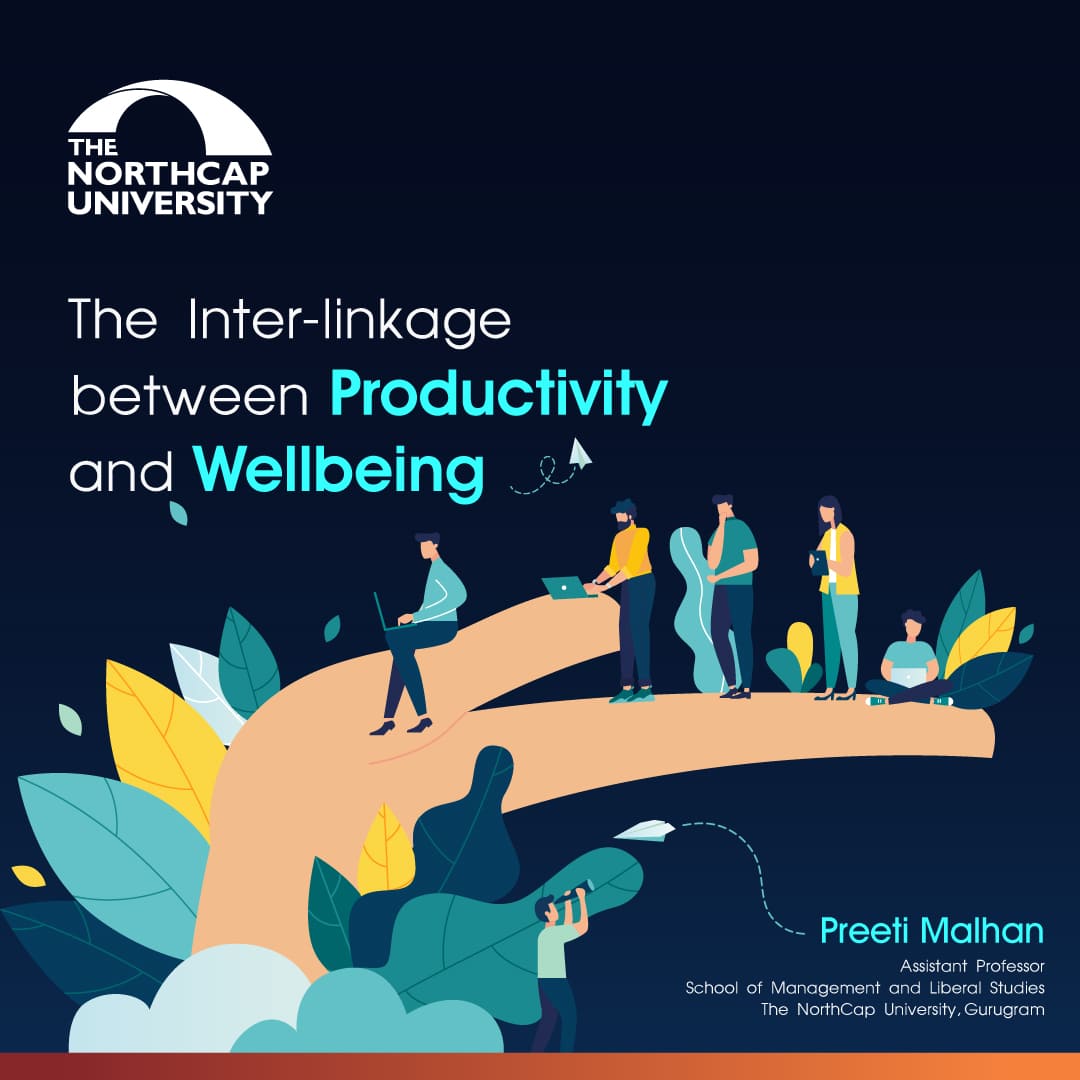The Inter-linkage between Productivity and Wellbeing

Productivity growth refers to the change in productivity over time. For example, if a worker increases their steel production from 10 tons per hour in year one to 20 tons per hour in year two, there is a 100% increase in productivity between the two periods.
However, it is important to note that productivity measurement can become more complex when dealing with multi-factor productivity, which considers multiple inputs (not just labour) and outputs in the production process. It aims to capture the overall efficiency of production by considering factors such as capital, technology, and other resources used to generate output. Additionally, accurately measuring outputs and inputs can be challenging in certain sectors or industries where the nature of production is more complex or where outputs are intangible (e.g., knowledge-based industries, services, or creative sectors). Efforts to develop appropriate metrics and methodologies for these cases continue to evolve. Overall, while productivity is conceptually straightforward as a ratio of outputs to inputs, accurately measuring and comparing productivity across different sectors and economies requires careful consideration of the specific outputs and inputs involved and the methodologies employed.
Wellbeing refers to the overall state of an individual’s physical, mental, and social health and encompasses their satisfaction with life and their ability to function effectively in various domains. It is a multidimensional concept that encompasses various aspects of an individual’s life and reflects their subjective experiences and objective conditions.
Objective Measures of Wellbeing: Objective measures of wellbeing typically rely on data collected by statistical authorities or other reliable sources. These measures often encompass indicators such as income and wealth distribution, access to education and healthcare, employment rates, housing conditions, environmental quality, and other relevant socioeconomic factors. They provide an assessment of wellbeing based on observable and quantifiable criteria.
The measurement of wellbeing can be approached from both objective and subjective perspectives. Each approach offers valuable insights and contributes to our understanding of what matters for creating a better society. Let’s explore these two perspectives:
Objective measures offer a broader societal perspective and help identify structural and systemic issues that can affect overall wellbeing. They allow for comparisons across populations and provide insights into disparities, inequalities, and areas that require policy attention. By analyzing objective indicators, policymakers can target specific areas for improvement, allocate resources effectively, and address societal challenges.
Subjective Wellbeing Measures: Subjective wellbeing refers to individuals’ own perceptions and evaluations of their wellbeing and life satisfaction. It is often measured through surveys that ask individuals to rate their happiness, life satisfaction, and overall wellbeing on a subjective scale. These surveys can capture emotional experiences, quality of life, social relationships, and other factors influencing individuals’ subjective wellbeing.
Subjective wellbeing measures provide a more individual-centered perspective, allowing individuals to express their own assessments of their wellbeing. They acknowledge that wellbeing is not solely determined by objective conditions but also influenced by personal perceptions, values, and life circumstances. These measures capture dimensions that may not be fully captured by objective indicators, such as the importance of social connections, self-fulfillment, and personal experiences.
The interplay between productivity and wellbeing is an important and complex topic that has garnered increased attention in recent years. Traditional measures of economic performance, such as GDP per capita, have limitations in capturing the overall wellbeing and quality of life experienced by individuals within a society. As a result, there has been a growing recognition of the need to explore alternative indicators that better reflect people’s wellbeing. On the other hand, it’s necessary to know the effect of wellbeing on productivity. The weaknesses of GDP as a proxy for wellbeing have become more apparent as societies have become more prosperous. While GDP measures the total economic output of a country, it does not consider factors such as income inequality, social connections, environmental sustainability, health, and overall life satisfaction. As societies have progressed, the pursuit of economic growth alone has not necessarily translated into enhanced wellbeing for all individuals.
Simultaneously, there has been a noticeable slowdown in productivity growth globally. Productivity is a measure of how efficiently inputs, such as labor and capital, are used to produce goods and services. Historically, productivity growth has been a key driver of increased living standards, as it enables greater output and economic gains without a proportional increase in inputs. However, in recent years, productivity growth rates have declined in many economies, which have implications for long-term improvements in living standards. The relationship between productivity and wellbeing is multifaceted and can operate in both directions.
On one hand, slower productivity growth can hinder improvements in living standards. When productivity growth is sluggish, it becomes challenging to achieve sustained increases in income and wealth, limiting opportunities for economic progress and social mobility. This can potentially impact overall wellbeing by restricting access to resources, education, healthcare, and other essential services.
On the other hand, there is evidence to suggest that certain aspects of wellbeing can positively influence productivity. For example, research has shown that employee wellbeing, including factors like job satisfaction, work-life balance, and mental health, can have a significant impact on individual and organizational productivity. Similarly, investments in public health, education, and social capital can contribute to a more productive workforce and society as a whole. Understanding the bidirectional linkages between productivity and wellbeing requires examining the pathways that operate from productivity to wellbeing and from wellbeing to productivity.
Let’s explore both directions:
Channels from Productivity to Wellbeing:
a. Economic Growth and Income: Higher productivity often leads to increased economic growth, which can contribute to higher incomes and standards of living. This can directly impact wellbeing by providing individuals and communities with greater resources and opportunities for personal fulfillment.
b. Employment and Job Quality: Productivity gains can create employment opportunities and improve job quality. When individuals have access to meaningful and secure employment with fair compensation, it positively influences their wellbeing.
c. Access to Goods and Services: Higher productivity can lead to greater availability and affordability of goods and services, including healthcare, education, and essential needs. Improved access to these resources enhances wellbeing by improving overall quality of life.
d. Innovation and Technological Advancement: Productivity growth often accompanies technological advancements and innovation. These developments can lead to the creation of new products, services, and industries, providing individuals with increased opportunities and potentially enhancing their wellbeing.
Channels from Wellbeing to Productivity:
a. Health and Wellness: Individuals with higher levels of wellbeing, including better physical and mental health, are more likely to be productive. Good health enables individuals to perform at their best, reducing absenteeism and enhancing overall works performance.
b. Work Engagement and Job Satisfaction: When individuals experience higher levels of wellbeing, they are more likely to be engaged and satisfied in their work. This can lead to higher levels of productivity, as individuals are motivated, focused, and committed to their tasks.
c. Social Capital and Collaboration: Wellbeing, particularly in terms of positive social relationships and trust, can foster social capital. Higher social capital promotes cooperation, collaboration, and knowledge sharing, ultimately enhancing productivity within organizations and communities.
d. Cognitive Functioning and Creativity: Wellbeing factors such as emotional wellbeing, stress management, and work-life balance can positively influence cognitive functioning and creativity. When individuals experience greater wellbeing, they can think more clearly, generate innovative ideas, and problem-solve effectively, contributing to increased productivity.
Given the potential bi-directional relationship between productivity and wellbeing, some argue that policies aimed at improving wellbeing can also serve as strategies to boost productivity growth. Understanding these paths helps policymakers and organizations develop strategies, that address both productivity and wellbeing. By considering the multidimensional nature of wellbeing and its reciprocal relationship with productivity, interventions can be designed to create positive feedback loops, where improvements in one domain lead to enhancements in the other, fostering sustainable gains in living standards and overall societal wellbeing. For instance, initiatives that promote work-life balance, invest in education and skills development, enhance social cohesion, and prioritize mental and physical health could positively impact both wellbeing and productivity. To fully understand the linkages between productivity and wellbeing, further research is necessary. This includes examining the specific mechanisms through which wellbeing affects productivity and identifying effective policy interventions that can foster both.
Additionally, developing comprehensive measures of wellbeing that go beyond economic indicators will be crucial for policymakers to make informed decisions that prioritize the overall welfare of the population. There are several other factors which are affecting productivity through wellbeing, for example social capital, trust. Social capital, which refers to the networks, relationships, and trust within a society, plays a significant role in fostering productivity. Higher levels of social capital can promote cooperation, collaboration, and efficient communication among individuals and organizations. Trust, as a key component of social capital, reduces transaction costs, enhances the flow of information, and enables more effective coordination, which can lead to increased productivity in various sectors of the economy.
Public health and environmental conditions also have notable effects on both wellbeing and productivity. When individuals have access to quality healthcare, preventive services, and a clean environment, they are more likely to experience better physical and mental health. Improved health and wellbeing contribute to increased productivity by reducing absenteeism, improving cognitive function, and enhancing overall work performance. Similarly, a healthy environment, free from pollution and other hazards, creates a conducive atmosphere for productivity and wellbeing.
Wellness programs, which encompass various initiatives aimed at improving employee health, can have positive effects on both wellbeing and productivity. These programs often include measures to promote physical fitness, mental health, work-life balance, stress management, and healthy lifestyle choices. By investing in employee wellbeing, organisations can create a supportive and positive work environment, leading to higher job satisfaction, reduced turnover, lower absenteeism, and increased productivity.
Overall, these factors demonstrate the interconnectedness between wellbeing and productivity. By recognizing and addressing the various dimensions of wellbeing, such as social capital, public health, environmental conditions, and employee wellness, policymakers and organizations can create conditions that foster both individual wellbeing and productivity. Implementing policies and programs that prioritize these aspects can contribute to a virtuous cycle where improved wellbeing enhances productivity, leading to further improvements in wellbeing and sustainable long-term growth.
In conclusion, the limitations of GDP as a measure of wellbeing and the slowdown in productivity growth have raised important questions about the interdependence of these two factors. While slower productivity growth can pose challenges to improving living standards, investing in policies that enhance wellbeing may contribute to reviving productivity growth. Understanding and harnessing the linkages between productivity and wellbeing can pave the way for more holistic approaches to economic and social development that prioritize the overall welfare of individuals and societies.
Author

Dr. Preeti Malhan
Assistant Professor, Department of SOM
The NorthCap University, Gurugram
